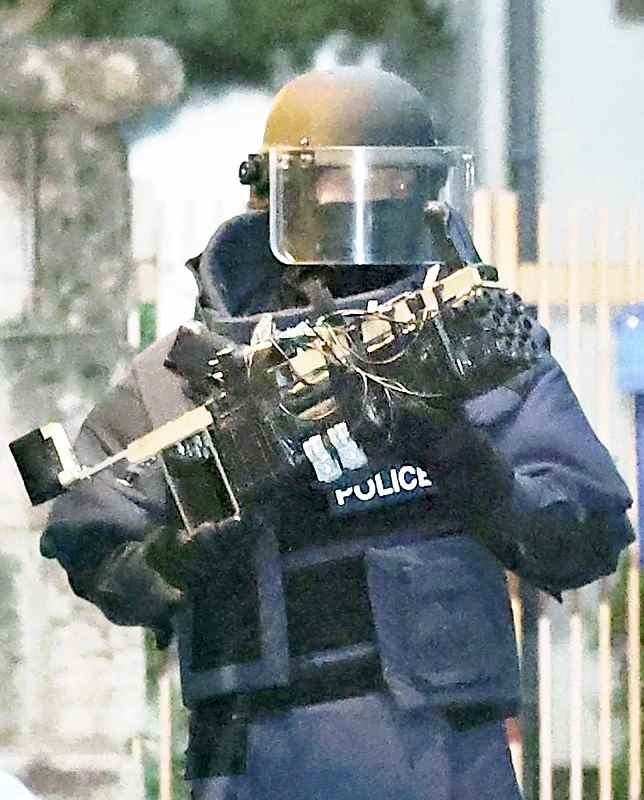Shooting suspect in slaying of Japan ex-PM Abe focused on making a ‘precision’ weapon

A police officer carries a handmade gun from the home of Tetsuya Yamagami in Nara City on July 8.
6:00 JST, July 18, 2022
NARA — When police investigating the shooting of former Prime Minister Shinzo Abe entered the suspect’s Nara apartment, they encountered a scene akin to an arms factory, finding multiple handmade guns, metal pipes, cans of gunpowder and various tools.
Nara prefectural police officers searched the home of Tetsuya Yamagami just after 5 p.m. on July 8, around the time Abe was pronounced dead at a hospital after being gunned down that morning during a stump speech for an upper house election candidate.
Yamagami, 41, reportedly spoke to investigators in an unimpassioned tone regarding the construction of his weapons. The shotgun-like firearm allegedly used in the fatal attack on Abe measured about 40 centimeters in length and 20 centimeters in height. Two metal pipes were each capable of discharging six projectiles; the pipes could be fired separately using a battery to ignite gunpowder. The weapon was so powerful that bullet-like holes from stray projectiles were found in the exterior walls of a multi-story parking garage about 90 meters from the crime scene.
The handmade guns found at Yamagami’s home — a six-tatami-mat-sized room about three kilometers from the crime scene — included a machine gun-like device comprising nine metal pipes bound together. It was rough in appearance, with haphazardly applied adhesive tape binding the pipes and exposed electrical cables.
“Such guns are clearly not the kind favored by gun enthusiasts,” said firearms journalist Tetsuya Tsuda. “It seems the guns prioritized practicality and a single goal: to kill.”
Yamagami reportedly harbored resentment toward a religious group widely known as the Unification Church after his mother became a member and donated a total of ¥100 million to the organization.
When the group — now officially called the Family Federation for World Peace and Unification and headquartered in South Korea — held an event in Japan, Yamagami wandered around the venue with a knife, and when the group’s leader visited Japan, he planned to attack her with a Molotov cocktail, but was unable to access the venue, according to the police.
The suspect subsequently switched his target to Abe, believing him to have connections with the Unification Church.
After attempting to create pressure-cooker based bombs similar to those used in violent attacks overseas, the alleged killer ultimately opted to use a gun because such weapons can “kill a target with precision and without hurting people who aren’t involved,” Yamagami was quoted as saying by the police.
Yamagami served in the Maritime Self-Defense Force in his 20s, during which time he likely gained a working knowledge of firearms.
“I watched video-sharing sites and other [sources] to learn how to make guns,” Yamagami reportedly told the police. “I started making them around autumn last year and completed the gun [used in the attack] this spring. I also made the gunpowder myself.”
Motoki Terui, a former researcher at the Ground Self-Defense Force’s Fuji School, said: “[The gun] was probably the suspect’s original, made using his existing knowledge and information gathered online. Too much gunpowder will cause the pipes to explode, and too little will make the weapon less powerful. He must have done a lot of research and experimentation, which shows an unusual level of persistence.”
There have been cases in which people have been arrested for making guns using three-dimensional printers based on blueprints obtained from the internet. Videos showing how to make guns and prepare gunpowder also can be found online.
It is not difficult to obtain the necessary materials to create a firearm: Metal pipes similar to those used by Yamagami to make guns are available at home improvement stores, and potassium nitrate and sulfur — which can be used to make gunpowder — are sold for agricultural use.
In Japan, the possession and manufacturing of guns is strictly regulated by laws. Unlike in the United States, where the right to possess guns is guaranteed by the Constitution, gun-related crimes are rare in Japan.
In the three years through 2021, there were 40 shooting incidents in the country, 80% of which were gang-related. Police primarily craft their response to shootings with gangs in mind — a lone-wolf attack had not been anticipated.
Terrorist attacks launched by single individuals can be difficult for police authorities to detect or thwart, as the perpetrators do not belong to any organization.
"Society" POPULAR ARTICLE
-

M4.9 Earthquake Hits Tokyo, Neighboring Prefectures
-

Israeli Tourists Refused Accommodation at Hotel in Japan’s Nagano Pref., Prompting Protest by Israeli Embassy and Probe by Prefecture
-

M7.5 Earthquake Hits Northern Japan; Tsunami Waves Observed in Hokkaido, Aomori and Iwate Prefectures
-

Tsukiji Market Urges Tourists to Avoid Visiting in Year-End
-

High School in Kyoto Says Students Shoplifted during Recent School Trip to Bali, Indonesia
JN ACCESS RANKING
-

Tokyo Economic Security Forum to Hold Inaugural Meeting Amid Tense Global Environment
-

Keidanren Chairman Yoshinobu Tsutsui Visits Kashiwazaki-Kariwa Nuclear Power Plant; Inspects New Emergency Safety System
-

Imports of Rare Earths from China Facing Delays, May Be Caused by Deterioration of Japan-China Relations
-

University of Tokyo Professor Discusses Japanese Economic Security in Interview Ahead of Forum
-

Japan Pulls out of Vietnam Nuclear Project, Complicating Hanoi’s Power Plans

























